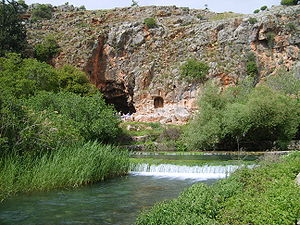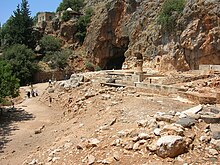Battle of Panium
This articlerelies largely or entirely on asingle source.(July 2024) |
| Battle of Panium | |||||||||
|---|---|---|---|---|---|---|---|---|---|
| Part of theFifth Syrian War | |||||||||
 The spring of Banias with the Cave of Pan in background | |||||||||
| |||||||||
| Belligerents | |||||||||
| Seleucid Empire | Ptolemaic Egypt | ||||||||
| Commanders and leaders | |||||||||
|
Antiochus III the Great Antiochus the Younger | Scopas of Aetolia | ||||||||
| Strength | |||||||||
|
70,000 men Unknown war elephants |
46,500–53,000 men 25,000–32,000 phalangites 6,000 Aetolian infantry 500 Aetolian cavalry 14,500–15,000 other troops | ||||||||
| Casualties and losses | |||||||||
| Unknown | 17,500–20,825 phalangites killed or captured | ||||||||
TheBattle of Panium/pəˈnaɪ.əm/(also known as Paneion,Ancient Greek:Πάνειον,or Paneas, Πανειάς) was fought in 200 BC nearPaneas(Caesarea Philippi) betweenSeleucidandPtolemaicforces as part of theFifth Syrian War.The Seleucids were led byAntiochus III the Great,while the Ptolemaic army was led byScopas of Aetolia.The Seleucids achieved a complete victory,annihilatingthePtolemaic armyand conquering the province ofCoele-Syria.The Ptolemaic Kingdom never recovered from its defeat at Panium and ceased to be an independentgreat power.Antiochus secured his southern flank and began to concentrate on thelooming conflictwith theRoman Republic.
Background
[edit]In 202 BC, Ptolemy son of Thraseas, thePtolemaicgovernor ofCoele-Syria,defectedto the side ofAntiochus III the Great,the ruler of theSeleucid Empire.[1]Antiochusinvadedand occupied most of the province, including thecityofGaza,by the autumn of 201 BC, when he returned towinter quartersin Syria.[1]The Ptolemaic commanderScopas of Aetoliareconquered parts of the province that winter.[1]Antiochus gathered his army atDamascusand in the summer of 200 BC, he confronted thePtolemaic armyat thestreamofPaniumnearMount Hermon.[1]
Prelude
[edit]Ptolemaic dispositions
[edit]The Ptolemaic front line was four kilometers wide.[2]The left wing was deployed on the plain below the Panium plateau.[3]It consisted of the 25,000–32,000 strongMacedonian settler phalanxunder the command of Ptolemy son of Aeropus, a Macedonian settler himself.[3]These were the Kingdom's best troops.[3]The supreme command was held by theAetolianmercenarygeneralScopas of Aetolia,who brought with him 6,500 Aetolian mercenaries, including 6,000infantryand 500cavalry.[4]
Seleucid dispositions
[edit]Antiochus probably had around 70,000 soldiers, more than the 68,000 with him at theBattle of Raphiain 217 BC.[2]Having re-conquered theUpper Satrapiesin the previous years, he could draw upon a larger resource base than before.[2]Polybiusidentifies the presence ofcataphracts,the elite cavalryagema,Tarentinesoldiers and more cavalry,phalangites,hypaspists,war elephants,unidentified infantry and lightskirmishersin the ranks of theSeleucid armyat Panium.[2]
Battle
[edit]
Antiochus the Younger,the firstborn son of Antiochus III, commanded the elite cataphracts of the Seleucid army and seized Tel Hamra, a foothill of Mount Hermon, in the night.[4]The cataphracts opened the battle by attacking and quickly routing the hapless Ptolemaic cavalry under Ptolemy.[4]
In the center, the Ptolemaic phalanx forced back their Seleucid counterparts.[4]The Seleucid elephants neutralized this Ptolemaic success by charging through the gaps in the Seleucid phalanx and halting their advance.[4]The cataphracts under Antiochus the Younger ended their pursuit of the enemy cavalry and charged the rear of the Ptolemaic phalanx.[4]Pressed from two sides by war elephants, phalangites, and cataphracts, the relatively immobile Ptolemaic phalanx was almost annihilated where they stood.[4]Scopas, situated on the right wing, fled the field, taking 10,000 troops with him.[5]
Aftermath
[edit]Scopas led 10,000 men to seek refuge atSidon;other Ptolemaic contingents fled toJerusalem,Phoenicia,SamariaandDecapolis.[6]All of them were forced to surrender by the end of 198 BC.[6]Coele-Syria came under Seleucid control and the Ptolemies were compelled to sign a peace treaty with Antiochus in 195 BC. As one of the battle's results, the Ptolemaic state was forced to scale down the role of the Macedonian settler phalanx in the years that followed.[7]
Some biblical commentators see this battle as being the one referred to inDaniel 11:15, where it says, "Then the king of the North will come and build up siege ramps and will capture a fortified city."[8]
Casualties
[edit]Based on the loss rates of the phalanxes at the battles ofMagnesiain 190 BC andPydnain 167 BC, the 25,000 Ptolemaic phalangites may have sustained 17,500–20,825 losses, killed or captured.[9]
Citations
[edit]- ^abcdJohstono 2017,p. 164.
- ^abcdJohstono 2017,p. 167.
- ^abcJohstono 2017,p. 166.
- ^abcdefgJohstono 2017,p. 168.
- ^Plb.16.18.
- ^abJohstono 2017,p. 165.
- ^Johstono 2017,p. 162.
- ^Jordan, James B.(2007).The Handwriting on the Wall: A Commentary on the Book of Daniel.American Vision.p. 558.
- ^Johstono 2017,p. 169.
Bibliography
[edit]- Johstono, Paul (2017). ""No Strength To Stand": Defeat at Panium, the Macedonian Class, and Ptolemaic Decline ". In Clark, Jessica H.; Turner, Brian (eds.).Brills Companion to Military Defeat in Ancient Mediterranean Society.Leiden:Brill Publishers.ISBN978-9004298583.
33°14′55″N35°41′40″E/ 33.24861°N 35.69444°E
External links
[edit]- Translation ofZeno's Account of the Battle of Panium
